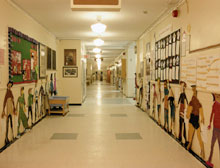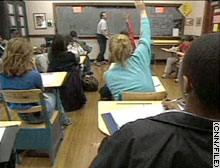Moving out of the traditional classroom
Alternatives emerge on the education scene
By Amy Cox
CNN
Friday, August 13, 2004 Posted: 9:38 AM EDT (1338 GMT)
 A growing number of students bypass school hallways, opting for learning online and at home.
A growing number of students bypass school hallways, opting for learning online and at home.CNN) -- Across the nation, on the Web and in the home, classrooms are evolving beyond the traditional learning environment with alternatives that are no longer bound by geography and customary modes of operation.
The majority of the approximately 54 million U.S. students still attend traditional public schools, but new educational options -- such as charter schools, home schools and distance learning -- are gaining ground and remain a subject of debate.
Twelve years after Minnesota opened the first one, charter schools -- publicly financed schools that operate largely independent of government regulation -- now count nearly 700,000 students. Recent figures put the number of children taught at home at more than a million, a 29 percent jump from 1999. And though no exact federal figures exist yet for online school enrollment, one research firm reports that 300,000 elementary and high school students logged on to a virtual learning class in the 2002-2003 school year. (Home school enrollment rising)
A challenging curriculum and personalized atmosphere prompted eighth-grader Teia Jenkins' move to a charter school, Gaston College Preparatory School in North Carolina.
As do students at the 31 other KIPP schools nationwide, Teia attends school from 7:30 or 8 in the morning to 5 p.m. and also takes part in mandatory classes on Saturdays and during the summer.
"In my old school, I used to be on honor roll, and it was easy," she said. "But now the work is more challenging, but I'm still on the honor roll."
Teia said she hopes the harder coursework during her two years at the school will help her reach her goal of attending Harvard University.
Teia's mom, Sandra Jenkins, said the charter school offers a more personalized touch. (More on charter schools)
"They have more time with each student. They go longer hours, but they're also making it fun," she said. "You don't get that in a normal public school -- there's just too many students and not enough time, not enough patience, and not enough consistency and communication that I've found here."
Personalization, flexibility
Demands for a more personalized approach to education as well as flexibility have spurred parents and students to seek alternatives to the traditional public classroom, said Earl Grier, principal of Commonwealth Connections Academy in Pennsylvania, a "public cyber charter school" in which classwork is done at home and online. (Online classes click with students)
"We meet with the parents at the beginning of the school year and design a direction for the student to go in," said Grier, who had spent more than 30 years at "brick-and-mortar" public schools. "In a classroom with 25 kids, you can't individualize the lesson on 25 different levels."
The students who benefit most from this kind of education tend to be either significantly ahead of or lagging behind their peers, Grier said. Flexibility also serves as an important factor for participating families.
"Kids can do the work anywhere they have the materials with them," he said. "With this school, they can do their work in their pajamas."
With a set of twins and triplets, the Tainsh family's need for flexibility spurred their enrollment in the Florida Virtual School, founded in 1997 with the intent to complement or supplement the state's traditional K-12 education. Most students take one or two classes because the subjects are not available at their regular school or they need to make up credits. But about 2 to 3 percent, including the Tainsh family members last year, go full-time.
"With this many kids, we never found one school that met all their needs," father Bob Tainsh said. "With this school ... we don't have to be adaptable, they're adaptable. They have a basic curriculum, but there's always flexibility."
"The thing I like the best is that you can do [schoolwork] whenever you want, wherever you want, just as long as you have a computer," said Valerie Tainsh, 14.
Students don't attend such programs just to escape traditional schools, said Florida Virtual School CEO Julie Young, but rather to find the educational path that works best for them.
"I think the myth would be that parents are so dissatisfied with public schools that they're turning to online education. If that were true, 98 percent of our students would not be taking one or two courses with us, [they'd be full-time]," she said. "What's happened in the last five years is that parents have come to appreciate the options out there and they want their kids to have the best education and the best opportunities."
Alternatives questioned
But some officials say sitting in front of a computer, learning beside family members or attending a school with a homogeneous student body might detract from a child's social education.
 Demands for personalization and flexibility have spurred some of the growth of classroom alternatives.
Demands for personalization and flexibility have spurred some of the growth of classroom alternatives."As children are growing up in an increasingly diverse world, they need to have exposure to people different than themselves," said Paul Houston, executive director of the American Association of School Administrators, a professional organization of 13,000 educational leaders. "I'm not saying it can't happen outside the public system, but it happens easily in the public system in many cases."
That's not to say those who attend nontraditional schools will be socially inept. Jeffrey Mirel, an education professor at the University of Michigan, said studies have shown that most home-schoolers, for example, participate in outside-classroom activities with other children and don't develop social problems.
But because most parents tend to gravitate toward people much like themselves, the diversity of play groups may be lacking, he said.
"My concerns about home schooling and my concerns about charter schools are very much that the kids are not going to get the kinds of broad experiences with people who are different from them and ideas that are different from those they find at home," Mirel said.
Scholastic achievement is not a sufficient reason to pick one kind of school over another either, according to Mirel, whose research focuses on school reform and the politics of urban education.
"Generally, the studies I've seen cited are not finding dramatic differences, particularly between charter schools and the regular public schools, in terms of achievement," he said. "It might be that the kids like school better or the parents are happier with the school, but in terms of achievement, there haven't been stark differences."
The future of the classroom
How will traditional public schools respond as these other education options grow in number and popularity?
Although computers and high-tech gadgets will remain integral to everyday life, Mirel said, online and distance learning will always take a back seat to traditional methods, especially in elementary and high schools. And though he expects the number of charter schools to increase, he said that ultimately, they are not going to be a significant challenge to the traditional schools.
"I think that more and more people are getting that option is a good thing," he said. "But whether that's going to lead to the improvement of public schools or whether that means charter schools are going to offer a much better alternative remains to be seen."
Young, the Florida Virtual School CEO, said she believes the burgeoning alternatives translate into greater choices for parents in how and where their children are educated.
"I have absolutely no premonition that traditional schools are going to disappear," she said. "Rather than assuming online learning, for example, is for everyone, it is giving students, schools and states one more option to provide for students."